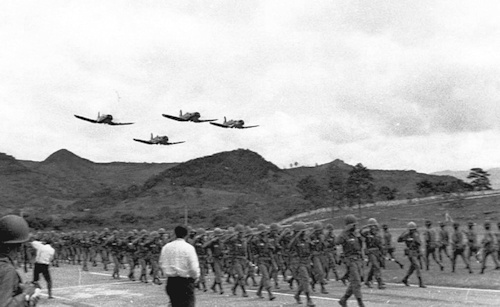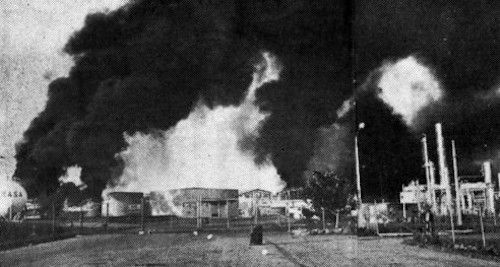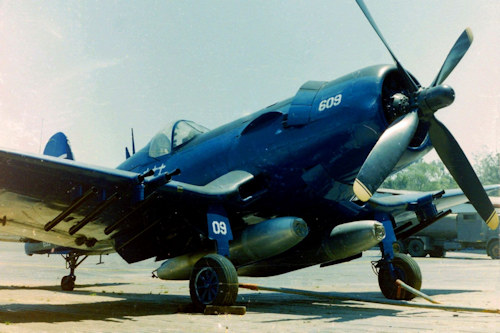The South American area has always been characterized by a strong political-economic instability such as to explode, in more than one occasion, into real armed conflicts. Clashes that have seen opposing different states of Latin America, even several times among them - see the various border conflicts between Ecuador and Peru, for example. Nothing was enough to stop these various military escalations, the somewhat dated war material often fielded by the various contenders. This was true for all South American armed forces, including military aviation. Emblematic in that sense was the so-called "Football War" fought in 1969 in Central America between the state of El Salvador, led by General Fidel Sanchez Hernandez, and Honduras, commanded by General Oswaldo Lopez Arellano.
Although gripped by severe budget constraints and widespread poverty, relying on US military supplies, the two countries mentioned had managed to create small air forces with famous but technologically outdated aircraft, such as the North American P-51 Mustang, Republic P-47 Thunderbolt and Vought F4U Corsair.
Among the models mentioned, the Vought F4U Corsair played a key role in the conflict between El Salvador and Honduras as these powerful fighter-bombers were the backbone of the belligerent air fleet.
 The FAH (Honduras Air Force) had twenty of F1956U-4, F4U-4 and FAU-5NL in it, starting from the 5. The FAS (the Military Aviation of San Salvador), however, deployed 24 (four F4U-5 and twenty FG-1D).
The FAH (Honduras Air Force) had twenty of F1956U-4, F4U-4 and FAU-5NL in it, starting from the 5. The FAS (the Military Aviation of San Salvador), however, deployed 24 (four F4U-5 and twenty FG-1D).
Means that would soon return to fight another war from there. In fact, during the summer of 1969, there was a strong tension between the two countries mentioned above, mainly for illegal migration problems from El Salvador - destined to train the workforce needed for the plantations of Standard Fruit and United Fruit - acute ever-bound border disputes.
When the Salvadoran migrants in Honduras came to the remarkable figure of 300.000 people, Honduran landowners increasingly exposed their discomfort to this situation. The discomfort of landowners soon spread to the rest of the population, which has been undergoing several growing anti-Salvadoran violence. Hundreds of laborers then had to leave Honduras despite attempts to mediate between the parties operated by then-president Lyndon Johnson and the Organization of the American States.
Attempts for mediation also failed because in the midst of the crisis it was well thought out that the eliminations of the World Cup were held between the two countries in Tegucigalpa (Honduras capital) and San Salvador (capital of the homonymous state). The matches were the occasion of further violence, even serious, between the two sides, which justified the breakdown of diplomatic relations between El Salvador and Honduras and the mobilization of their respective armed forces.
Given the growing tension of the tide, it was natural that sooner or later an accident would come out to justify an armed conflict. This was exactly the 3 July 1969, when the Salvadoran counterattack opened fire against a DC-3 of Honduras's Servicio Aéreo, which was inside its airspace. In response, the FAH sent two T-28s in the area of the incident, which were also shot down by anti-aircraft. On the same day, in Honduran airspace, two more T-28 intercepted a Salvador Salvador's Piper Cherokee engaged as a camouflage detective and tried to get him landed on one of their tracks without having to.
The war "war" was around the corner now. The 12 July was declared the state of alert in both countries.
 At the time of the start of hostilities, FAH could count on the following fully operational aircraft assets: 14 Corsair, alongside five C-47 Skytrain, a C-45 Expeditor, five armed T-28A and six Texan. For FAS the numbers were even smaller. At the time of the start of hostilities with Honduras they could be considered operative and available for warfare needs only four / six Corsair, some Mustang, a B-26B, an SNJ-5 Texan, a Canadair DC-4M, eleven civilized "militarized" civil aircraft and three C-47.
At the time of the start of hostilities, FAH could count on the following fully operational aircraft assets: 14 Corsair, alongside five C-47 Skytrain, a C-45 Expeditor, five armed T-28A and six Texan. For FAS the numbers were even smaller. At the time of the start of hostilities with Honduras they could be considered operative and available for warfare needs only four / six Corsair, some Mustang, a B-26B, an SNJ-5 Texan, a Canadair DC-4M, eleven civilized "militarized" civil aircraft and three C-47.
Beginning the dances was, however, the same FAS as the 14 July, with a C-47 converted into "rustic bomber" by removing the cargo port to facilitate the release of bombs from 45 kg, attacking the important Tegucicalpa airport -Toncontin in Honduran territory with the escort of two Mustang which later hit the villages of El Suyatal, Gaimaca and Jalteva. FAH's reaction was totally inadequate and inadequate: its own Corsair they failed to intercept the C-47 "intruder" and the anti-aircraft had no better luck. Although the Salvadoran action brought very modest practical results, the psychological effect on Hondurans was enormous as they were caught by surprise (a sort of Flight over Vienna in South American sauce). In the face of such an affront it was absolutely necessary to react as soon as possible. Therefore, at the 23: 00 of the same day, the Honduran government specially convened by the president, decided to carry out a retaliation aimed at destroying as many enemy aircraft as possible by attacking its airports. For this purpose a C-47 was set up - as had previously been done by the adversaries - equipped with rails in the hold to slide 18 bombs up to the 45 kg.
 In the night between the 14 and the 15 July the C-47 Honduran took off in the direction of San Salvador but almost immediately had to return due to unforeseen technical problems. In a hurry and fury was put up another airplane of the same model that took off from its base at 3.30. The pilot of the aircraft, orienting himself only with compass and clock, arrived in what he thought was the area of the target and unhooked all his bombs, without causing damages. As the results were in short supply, it was decided to take off three F4.30U-15Ns and one F4U-5 in the 4 of the 4 in July to machine and break the Ilopango airport and the port of Cutuco.
In the night between the 14 and the 15 July the C-47 Honduran took off in the direction of San Salvador but almost immediately had to return due to unforeseen technical problems. In a hurry and fury was put up another airplane of the same model that took off from its base at 3.30. The pilot of the aircraft, orienting himself only with compass and clock, arrived in what he thought was the area of the target and unhooked all his bombs, without causing damages. As the results were in short supply, it was decided to take off three F4.30U-15Ns and one F4U-5 in the 4 of the 4 in July to machine and break the Ilopango airport and the port of Cutuco.
Honduras aircraft dropped several bombs but did not explode. Those deflated, however, caused enormous damage: at Ilopango a track was centered in full as well as a tank truck and some spare engines for the DC-4. Cutuco, on the other hand, was hit and destroyed several oil and fuel tanks "for civil use".
The material damage of Salvador would have risen thereafter, due to an attack by another four Honduran F4U-4s against the storage tanks of the port of Acajutla (photo) which resulted in the loss of about 20% of oil stocks.
The Salvadoran military reacted weakly to these successful "strikes": in the late afternoon of July 15, FAS returned to bomb Toncontin airport with an FG-1D and a Mustang. They then took off to try to intercept a T-28 and a FG1-D. The latter, however, immediately had to abandon the mission because of a problem in the fire control of the cannon. The remaining T-28 managed to score a few hits on the attacking FG-1D which managed to return to the base anyway.
 The 16 July began the earth attack of Salvador, to support it, besides the artillery, there was an FG-1D and a Mustang. But it would be the next day, the 17th, the decisive day to establish the domination of the airspace of the battlefield. On that day, in fact, Maj. Fernando Soto Henriquez (opening photo), on an F4U-5 (photo) on a surveillance mission, with two other wingmen, managed to intercept and attack two Mustang Salvadorans. After exchanging blows with his enemies, he managed to hit the engine of one of the enemy fighters that crashed, causing the pilot's death, cap. Douglas Varela.
The 16 July began the earth attack of Salvador, to support it, besides the artillery, there was an FG-1D and a Mustang. But it would be the next day, the 17th, the decisive day to establish the domination of the airspace of the battlefield. On that day, in fact, Maj. Fernando Soto Henriquez (opening photo), on an F4U-5 (photo) on a surveillance mission, with two other wingmen, managed to intercept and attack two Mustang Salvadorans. After exchanging blows with his enemies, he managed to hit the engine of one of the enemy fighters that crashed, causing the pilot's death, cap. Douglas Varela.
But the magg. Soto Henriquez had not finished yet. While attaching a battery from 105 mm along with the trimmer, ch. Edoardo Acosta and Francisco Zapeda, he saw two FG-1 D tallers in the sky. Immediately engaged, Soto Henriquez first fired the cap FG-1D. Salvador Cazena Amaya, forcing him to launch with parachute, and then the cap. Guillermo Reynaldo Cortez found himself with a truncated net wing due to a burst of 20 mm cannons so that it exploded in the air.
The FAH had thus reached the absolute control of the heavens after having successfully supported these two aerial fights. But he could not enjoy it for long. The 18 July the OAS was able to impose a ceasefire between the parties that was essentially respected except for small clashes up to the 20 July between terrestrial departments of the two contenders.
So it ended, a bit at the "chetichella", the "Football War" and its air combat fights with aircraft dating back to IIa GM
(photo: web)












